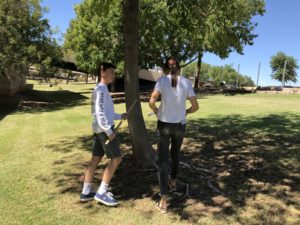10 Ways to Teach It Outside

To view the photo-rich magazine version, click here.
Originally appears in the Winter 2019 issue.
“Without that deep abiding sense of comfort in and love for the natural world, no amount of chastising about turning off the lights or biking to school is going to make a bit of difference.”
—David Sobel
A SENSE OF COMFORT in and love for nature — what so many of us want for our students — comes from spending time meaningfully interacting with the great outdoors. My own affection and passion for promoting conservation locally and globally is founded in my experiences and connections to gardening, watching bird feeders with my parents, and exploring local wild spaces. Just like any topic or concept I am bringing into my classroom, I cannot assume that my students have the same foundational experiences as I do. In fact, some of my students have shown fear, annoyance, and total discomfort with natural experiences. To overcome these barriers, we need to let our students practice interacting with nature in the same ways that we would have them practice vocabulary terms, lab skills, and other fundamental skills: through repeated exposure and hands-on experiences.
While parks, zoos, riparian preserves, and national forests would be amazing places in which to foster connections to the outdoors, we do not have to plan extensive and/or expensive field trips to get our students outside. Using our own school yards and encouraging students to explore their neighborhoods can be rewarding as well. Taking the classroom outdoors not only helps students practice interactions with nature; it provides opportunities for students to act and positively influence the ecosystem on their own campus. This is especially important if the campus does not have a lot of biodiversity. Showing students that nature can be found close to home and school also allows them to continue developing their connection to nature, and it establishes that urban environments are important ecosystems too.
Following are ten meaningful and standards-based ways that we can use our school yards to connect middle and high school students to nature in relevant ways that benefit their well-being, and fulfill our desires for our students to become concerned and participatory citizens.
This content is restricted to subscribers only.
If you are not yet a subscriber, please consider taking out a subscription here.
If you are an existing subscriber, kindly log in or contact us at info@greenteacher.com for more information.










